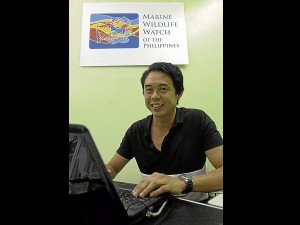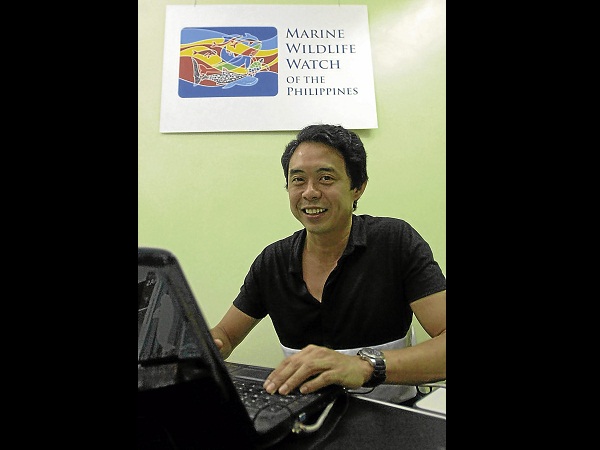
More often than not, people are carried away by the novelty of it all. In a luxury resort, you pay a fee to fish a baby turtle out of a tank and “release” it into the wild. In Oslob, Cebu, people are going wild over the “touching” relationship between fishermen and the whale sharks they habitually feed.
“The animals are running after boats like hungry puppies, and people think it’s cute,” says Dr. Arnel “AA” Yaptinchay, founder and director of Marine Wildlife Watch of the Philippines, the nonprofit, nonstock organization this veterinarian and conservation worker founded in September 2010 to help people develop a better understanding of the marine environment.
Yaptinchay has made social networking—specifically, Facebook—his main platform, and he’s reaching thousands of people who otherwise would have no idea why it’s now a bad idea—nay, almost criminal—to eat shark’s fin soup.
“Ecotourism should have an educational aspect to it. Unfortunately, a lot of people are not interested in being educated; they just want to be entertained. What people don’t understand is that whale sharks have a complex life cycle; they migrate, swimming as far as Taiwan and Vietnam, and spend a lot of time at depth. If you change that, you affect not only their migratory habits, but even their reproduction and instincts for survival, and you put them in danger.”
In short, these 15-ft puppies may think every hand is a friendly one—and may one day run into one of the many shark fishermen who still prowl Philippine waters to slaughter these magnificent creatures for their fins.
Meanwhile, Yaptinchay explains, turtle hatchlings have to be out at sea within three to five days of emerging from their nests, to get the imprint of the beach where they were born and to get on with their complex life cycles as the gardeners of the sea. “If you put them in a tank, how is that supposed to happen?”
Endangered
The fact is, all turtles in Philippine waters have been classified as endangered by the Philippine Wildlife Act, with Hawksbill turtles (Eretmochelys imbricata) being critically endangered. “In short, nobody should have a turtle in captivity, but because of lack of enforcement, nakakalusot. We see a lot of misguided ecotourism, and it has become part of the threat rather than the solution.”
So what exactly makes a good ecotourism destination? “We look at three factors,” says Yaptinchay. “There’s the natural component. There’s the community; somehow the local community should benefit from the tourism business. And finally, the visitor should be educated and come away with something.”
Reality, however, often means a compromise. “Tourism is always a business, and for that you need infrastructure, services, attractions, accessibility. I’m all for tourism, but a balance can be struck.”
Yaptinchay knows whereof he speaks. After earning his veterinary medicine degree from the University of the Philippines in 1991, he went on to his first job with the Department of Environment and Natural Resources’ (DENR) Marine Turtle Conservation Project, living and working in the Turtle Islands, one of the Philippines’ most isolated protected areas and one of the Asian region’s last major nesting and breeding sites of marine turtles. “Working with turtles was a life-changing experience,” he says, “because I’m still at it, 20 years later.”
He went on to work for the renowned conservation organization, World Wide Fund for Nature (WWF) Philippines, becoming director of the Marine Species Conservation Program, during which he also earned a master’s degree in international studies in aquatic tropical ecology from the University of Bremen, Germany.
A brief burnout saw Yaptinchay changing tack and establishing a travel agency in 2005, which is how he got his feet very wet in tourism. “I felt the problems were not problems of the community, but of the whole nation, so if I wanted a change, the whole nation had to change. That’s why I decided to try something else,” he says of the hiatus from saving the seas.
Still, “conservation wouldn’t leave me,” he adds with a laugh. Colleagues were still consulting him often as a marine wildlife expert, one of a handful in the Philippines, an irony in a country that is an archipelago embraced by water.
Today, through Marine Wildlife Watch Philippines, he has already partnered with the DENR and the United Nations Environment Programme (UNEP) on projects, including a manual for coastal communities on how to rescue a marine creature in distress.
Sexy, cute species
Yaptinchay is quite straightforward about his goal. “I’m using the sexy, cute species like turtles, dolphins, whales, and sharks to make people appreciate the ecology more, and realize we’re all connected.”
Facebook has been a boon to this academician who enjoys lecturing and patiently explaining the complex life cycles of such creatures to even the most unenlightened listeners. “What I post on our Facebook page can reach about 4,000-plus people. That’s a lot more than lecturing to a room with 20 people.”
Part of his self-confessed job as an “educator” is posting information as often as five times a day, from data discovered on the Internet, to original material gleaned from Yaptinchay’s own scientific studies and the work he does with local and international partners.
So how can you make an average tourist, for example, see the value of a charismatic but often stereotyped creature like a shark?
Many of the animals Yaptinchay is targeting share many characteristics, such as long lifespans and slow rates of reproduction. “When the harvest exceeds a certain limit, it starts affecting populations—that’s when we categorize them as vulnerable or endangered.”
Globally, about 73 million sharks a year are killed just for shark’s fin soup, he reveals—a delicacy that is all about prestige and status, and has no flavor or nutritional value to speak of. In the Philippines, President Fidel V. Ramos banned the killing of whale sharks and manta rays in 1998, leaving all other species still fair game, although manta fisheries remain active all over the country.
“The shark is what is known as an apex predator, and has been around for 165 million years, with an important role to play in the ecosystem,” Yaptinchay explains.
Apex predators function mainly to curb populations of smaller predators and keep them from cleaning out the small stuff—including the fish that we catch and eat on a daily basis. Lose your apex predators, your water police, and you will have the equivalent of anarchy in the ocean.
For an ecotourism facility to be legitimate, Yaptinchay stresses, “All decisions in terms of managing, operationalizing, and developing tourism in natural sites should be based on the ecological and biological needs of an area and its animals. When you make decisions for economics and politics, it’s never good for nature.”
Every time you see a wild animal in a cage, the responsible ecotourist must ask if the creature’s biological needs are being fulfilled, Yaptinchay concludes, in reference to the proliferating water attractions that make captive marine animals the stars of the lucrative show.
Such shows are watched by hundreds of children who grow up thinking that this is the right way to treat a marine animal. “If you can fulfill all those needs in a cage, no problem,” Yaptinchay challenges. “If you can allow a captive dolphin to swim 1,500 miles deep, or the hundreds of miles a day it needs to swim—if you can build a cage that big, then by all means, do it.”
Like their FB page, Marine Wildlife Watch of the Philippines.
How to be a responsible water tourist
1) Always practice respect. You are intruding into the marine animal’s world, not the other way around. Don’t litter, destroy coral, or make too much noise. Don’t harm an animal or do anything unnatural like feeding it, hurting it, or capturing it and bringing it with you.
2) Read up. Educate yourself. Understand what kind of impact you’re making on the ocean, and teach your kids.
3) Watch the garbage! “Trash is one of the single biggest problems in our islands and coasts brought by tourism,” says Yaptinchay. Try to live in a sustainable way—reduce your waste, buy local, consume less—and for the millionth time, don’t throw cigarette butts or plastic bags in the ocean. You already know they can kill.
4) Don’t support facilities that pretend to know what they’re doing. Other facilities are just making honest mistakes and have to be guided; others are very much aware and just want to make money in the guise of environmentalism, notes Yaptinchay. Be a discriminating tourist.














































